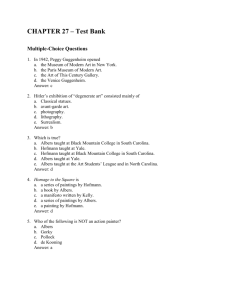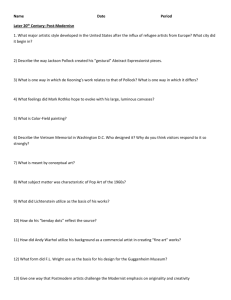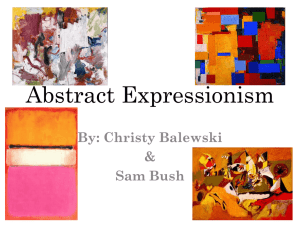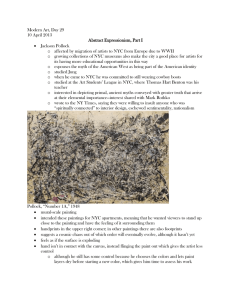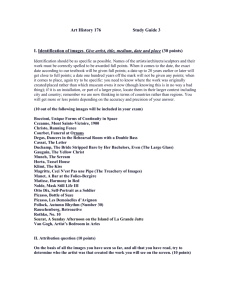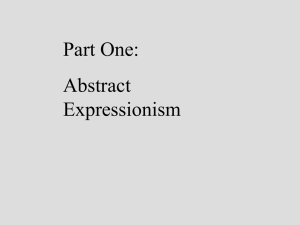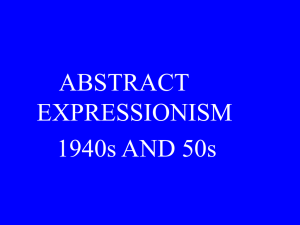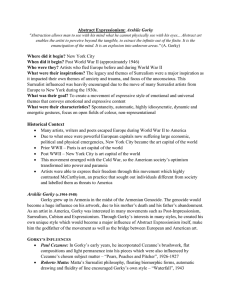CHAPTER 27 Mid-Century Abstraction Multiple
advertisement
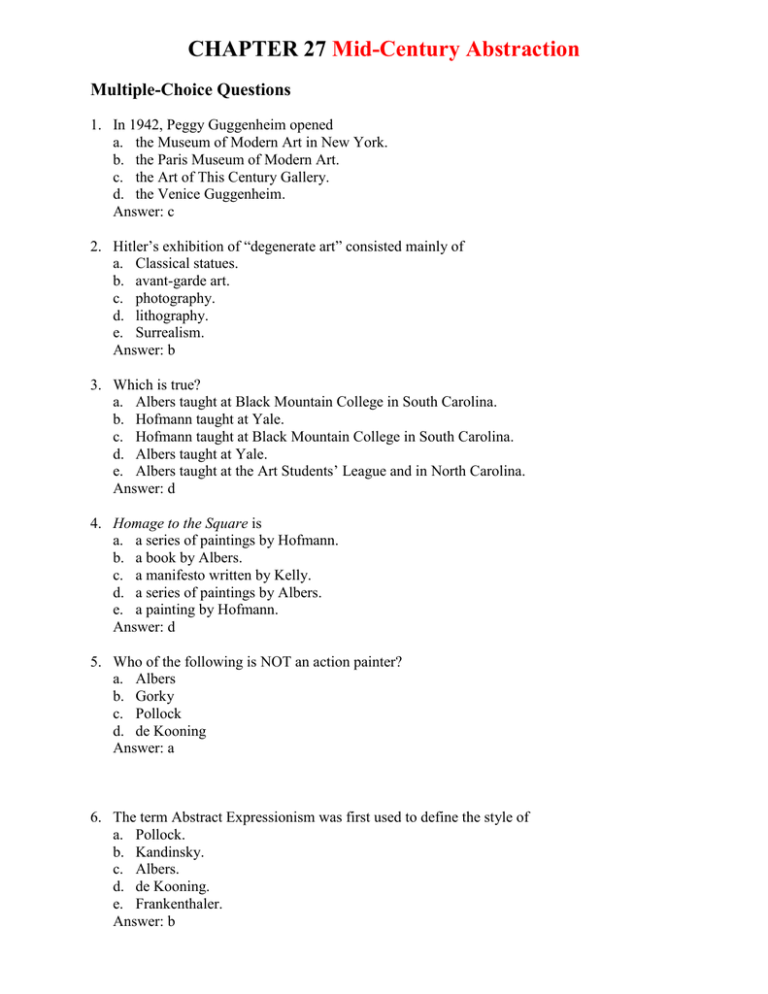
CHAPTER 27 Mid-Century Abstraction Multiple-Choice Questions 1. In 1942, Peggy Guggenheim opened a. the Museum of Modern Art in New York. b. the Paris Museum of Modern Art. c. the Art of This Century Gallery. d. the Venice Guggenheim. Answer: c 2. Hitler’s exhibition of “degenerate art” consisted mainly of a. Classical statues. b. avant-garde art. c. photography. d. lithography. e. Surrealism. Answer: b 3. Which is true? a. Albers taught at Black Mountain College in South Carolina. b. Hofmann taught at Yale. c. Hofmann taught at Black Mountain College in South Carolina. d. Albers taught at Yale. e. Albers taught at the Art Students’ League and in North Carolina. Answer: d 4. Homage to the Square is a. a series of paintings by Hofmann. b. a book by Albers. c. a manifesto written by Kelly. d. a series of paintings by Albers. e. a painting by Hofmann. Answer: d 5. Who of the following is NOT an action painter? a. Albers b. Gorky c. Pollock d. de Kooning Answer: a 6. The term Abstract Expressionism was first used to define the style of a. Pollock. b. Kandinsky. c. Albers. d. de Kooning. e. Frankenthaler. Answer: b 7. Which of the following correctly matches artist with country of birth? a. de Kooning – Germany b. Stella – Italy c. Gorky – Armenia d. Rothko – the United States e. Noguchi – China Answer: c 8. Which artist often depicted biomorphic shapes? a. de Kooning b. Noguchi c. Gorky d. both Noguchi and Gorky e. All these answers are correct. Answer: d 9. The two leading art critics of Abstract Expressionism were a. Bloomberg and Rosenberg. b. Steinberg and Bloomberg. c. Greenberg and Wölfflin. d. Worringer and Wölfflin. e. Greenberg and Rosenberg. Answer: e 10. Navajo sand painting inspired which artist? a. Rothko b. Ernst c. Pollock d. Frankenthaler e. Noguchi Answer: c 11. What artist was best known for his/her use of the drip technique? a. Frankenthaler b. de Kooning c. Gorky d. Pollock e. Hofmann Answer: d 12. Which is NOT true of acrylic? a. It is water-based. b. It can be used on paper but not canvas. c. It comes in bright colors. d. It dries quickly and does not fade. e. It can be poured, dripped, or splattered. Answer: b 13. Who of the following is NOT a Color Field painter? a. Mondrian b. Rothko c. Kelly d. Stella Answer: a 14. Which of the following correctly matches artist with work? a. Diebenkorn – The Artist and His Mother b. Kelly – Ocean Park No.129 c. Noguchi – Kouros d. Nevelson – the Cubi Series e. Gorky – Homage to the Square Answer: c 15. Which is LEAST true of Dubuffet? a. He collected non-Western art. b. He was a monochromatic painter. c. He liked textured surfaces. d. He was a figurative abstractionist. e. He was French. Answer: b 16. In this chapter, the artist who made furniture, playgrounds, and public sculpture gardens was a. Smith. b. Nevelson. c. Kline. d. Noguchi. e. Bacon. Answer: d 17. The painter who was most instrumental in creating a transition from European to American Abstract Expressionism was a. Mark Rothko. b. Willem de Kooning. c. Jackson Pollock. d. Arshile Gorky. e. Franz Kline. Answer: d 18. Who used acrylic to “stain” the canvas? a. Frankenthaler b. Rothko c. Gorky d. Smith e. Noguchi Answer: a Key Works Hans Hofmann, The Gate, 1959–1960 Josef Albers, Study for Homage to the Square, 1968 Arshile Gorky, The Artist and His Mother, c. 1926–1936 Photographer unknown, Arshile Gorky and His Mother, n.d. Arshile Gorky, Portrait of the Artist and His Mother, 1926/1936 Arshile Gorky, Garden in Sochi, c. 1943 Jackson Pollock, Going West, 1934–1935 Jackson Pollock, Guardians of the Secret, 1943 Hans Namuth, Jackson Pollock Painting, 1950 Hans Namuth, Jackson Pollock Painting, still from a film strip, 1950 Navajo man creating a sand painting Yei god, sand painting, (Navajo) 20th century Jackson Pollock, White Light, 1954 Franz Kline, Mahoning, 1956 Willem de Kooning, Woman and Bicycle, 1952–1953 Mark Rothko, Baptismal Scene, 1945 Mark Rothko, Number 15, 1957 Helen Frankenthaler, The Bay, 1963 Frank Stella, Empress of India, 1965 Frank Stella, Tahkt-i-Sulayman I, 1967 Ellsworth Kelly, Spectrum III, 1967 Installation view of Classic Modernism: Six Generations; on right: Ellsworth Kelley, Red, Yellow, Blue, 1965; on left: Piet Mondrian, Trafalgar Square, 1939; exhibition held November 15–December 29, 1990, Sidney Janis Gallery, New York Richard Diebenkorn, Ocean Park No. 129, 1984 Jean Dubuffet, The Reveler, 1964 Spirit figure from Wapo Creek, Papua New Guinea Francis Bacon, Portrait of Isabel Rawsthorne Standing in a Street in Soho, 1967 Isamu Noguchi, Kouros, 1944–1945 Louise Nevelson, Black Wall, 1959 David Smith, Cubi XXVII, 1965 Key Terms acrylic airbrush drip technique stain painting
